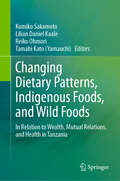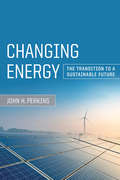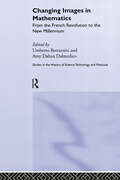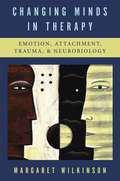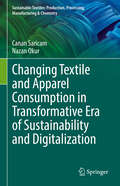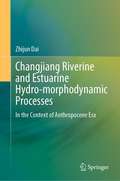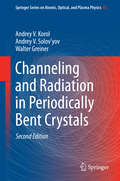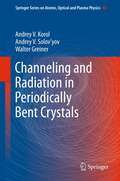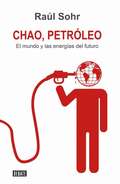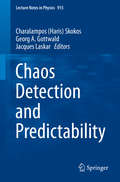- Table View
- List View
Changing Dietary Patterns, Indigenous Foods, and Wild Foods: In Relation to Wealth, Mutual Relations, and Health in Tanzania
by Kumiko Sakamoto Lilian Daniel Kaale Reiko Ohmori Tamahi KatoThis book presents different dietary patterns, some utilizing wild foods and others facing drastically changing dietary patterns, and shows their implications for health in terms of wealth, mutual assistance, food sufficiency and food diversity. The book examines these globally important issues through a case study of Tanzania. Using a novel methodology based on a global standard quality of life indicator, the book sheds light on the relationship between wild food intake and health in Tanzania. Descriptive case studies illustrate the impact of various food patterns and wild food intake on human health. It also highlights the divergence between food production sufficiency and food diversity. It then discusses the influence of wealth, mutual relations, and methods of food access. Finally, the book concludes with recommendations for maintaining good health in various environments. The intended readers of this book are academics and professionals in the fields of development, nutrition, and environment in East Africa. These include, but are not limited to, regional and district personnel who are actively engaged in development, relevant ministries of food and agriculture, and international organizations such as FAO, UNICEF, UNDP, and UNEP. In the academic field, students and researchers in international studies, development studies, African studies, social studies, cultural studies, nutrition, agriculture, and environmental studies are targeted.
Changing Earth
by Barbara M. LindePerform this script about a Paiute Indian leader, writer, and teacher who tried to make life better for her people. (Set of 12 with Teacher's Guide)
Changing Earth
by Barbara M. LindePerform this script about a Paiute Indian leader, writer, and teacher who tried to make life better for her people. (Set of 12 with Teacher's Guide)
Changing Earth
by Barbara M. LindePerform this script about a Paiute Indian leader, writer, and teacher who tried to make life better for her people. (Set of 12 with Teacher's Guide)
Changing Earth
by Janette SchusterNIMAC-sourced textbook <p><p> Changing Earth introduces students to the earth science concept of how the distinct features of Earth came to be.
Changing Energy: The Transition to a Sustainable Future
by John H. PerkinsChanging Energy outlines how humanity established the current energy economy through three previous transitions, and how we now stand poised for a necessary fourth transition. Human societies around the globe have received immense benefits from uses of coal, oil, gas, and uranium sources, yet we must now rebuild our energy economies to rely on renewable sources and use them efficiently. The imperative for a fourth energy transition comes from dangers related to climate change, geopolitical tensions, documented health and environmental effects, and long-term depletion of today’s sources. John H. Perkins argues that a future in which current levels of energy service benefits are sustained can come only from investments in the technologies needed to bring about a fourth energy transition. Changing Energy envisions a viable post–fossil fuel economy and identifies the barriers to be overcome.
Changing Habitats
by Smithsonian InstitutionChanging Habitats is part of the Smithsonian Science Stories™ Literacy Series and has on-grade and below-grade leveled readers available to accommodate a range of readers in an elementary classroom. The line and dot graphic at the bottom of the front cover indicates the reading level. When the dot is at the top of the line, the reading level for the book is on-grade. When it is at the bottom, the book is below-grade. You can also find the official Lexile Scores for each reading in the Table of Contents. The books in this literacy series enhance and reinforce the science concepts taught in the Smithsonian Science for the Classroom™ curriculum units.
Changing How We Choose: The New Science of Morality
by A. David RedishThe &“new science of morality&” that will change how we see each other, how we build our communities, and how we live our lives.In Changing How We Choose, David Redish makes a bold claim: Science has &“cracked&” the problem of morality. Redish argues that moral questions have a scientific basis and that morality is best viewed as a technology—a set of social and institutional forces that create communities and drive cooperation. This means that some moral structures really are better than others and that the moral technologies we use have real consequences on whether we make our societies better or worse places for the people living within them. Drawing on this new scientific definition of morality and real-world applications, Changing How We Choose is an engaging read with major implications for how we see each other, how we build our communities, and how we live our lives.Many people think of human interactions in terms of conflicts between individual freedom and group cooperation, where it is better for the group if everyone cooperates but better for the individual to cheat. Redish shows that moral codes are technologies that change the game so that cooperating is good for the community and for the individual. Redish, an authority on neuroeconomics and decision-making, points out that the key to moral codes is how they interact with the human decision-making process. Drawing on new insights from behavioral economics, sociology, and neuroscience, he shows that there really is a &“new science of morality&” and that this new science has implications—not only for how we understand ourselves but also for how we should construct those new moral technologies.
Changing Images in Mathematics: From the French Revolution to the New Millennium (Routledge Studies in the History of Science, Technology and Medicine #13)
by Umberto Bottazzini Amy Dahan DalmedicoThis book focuses on some of the major developments in the history of contemporary (19th and 20th century) mathematics as seen in the broader context of the development of science and culture. Avoiding technicalities, it displays the breadth of contrasting images of mathematics favoured by different countries, schools and historical movements, showing how the conception and practice of mathematics changed over time depending on the cultural and national context. Thus it provides an original perspective for embracing the richness and variety inherent in the development of mathematics. Attention is paid to the interaction of mathematics with themes whose proper treatment have been neglected by the traditional historiography of the discipline, such as the relationship between mathematics, statistics and medicine.
Changing Large Technical Systems
by Jane SummertonThis international anthology presents case studies of historical and contemporary transformations of large technical systems such as railways, telecommunications, electricity, and automobiles. The authors, working at the forefront of historical and social science research on the dynamics of large technical systems, analyze how and why these systems undergo change. Because of their important roles in contemporary society, large technical systems such as railways, airlines, road systems, telecommunications, and electric power network share drawing considerable academic and political interest. In this collaborative study on processes of change in large technical systems, the contributing authors present historical and current case studies of transformation within these systems. Working at the forefront of historical and social science research on the dynamics of large technical systems, the authors specifically analyze how and why the systems undergo change. In some cases, new technologies are solving old problems and presenting opportunities for system growth. In other areas, new regulatory approaches have brought competition and deregulation, often posing challenges to system builders. The authors also show how the breakup of national boundaries and new corporate strategies for global management of technology are transforming systems in ways that will have significant impacts on all consumers
Changing Minds in Therapy: Emotion, Attachment, Trauma, and Neurobiology (Norton Series on Interpersonal Neurobiology)
by Margaret WilkinsonAddresses the flurry of questions about the practical application of neuroscience in clinical treatment. Recent advances in research in the fields of attachment, trauma, and the neurobiology of emotion have shown that mind, brain, and body are inextricably linked. This new research has revolutionized our understanding of the process of change in psychotherapy and in life, and raised a flurry of questions about the practical application of neuroscience in clinical treatment, particularly with those who have experienced early relational trauma and neglect. What insight does neuroscience offer to our clinical understanding of early life experiences? Can we use the plasticity of the brain to aid in therapeutic change? If so, how? Changing Minds in Therapy explores the dynamics of brain-mind change, translating insights from these new fields of study into practical tips for therapists to use in the consulting room. Drawing from a wide range of clinical approaches and deftly integrating the scholarly with the practical, Margaret Wilkinson presents contemporary neuroscience, as well as attachment and trauma theories, in an accessible way, illuminating the many ways in which cutting edge research may inform clinical practice.
Changing Patterns in Israel Agriculture (Routledge Library Editions: Agriculture #6)
by Haim HalperinFirst published in 1957. This study sought to analyse the problems raised by the changing forces and conditions in Israel in the middle of the twentieth-century. It discusses the impact of Israel’s achievement of political sovereignty upon its agricultural economy in the comparatively short space of six years. It examines the agricultural problems that arose as functions of the natural factors of production – land, water, climate, etc. It endeavoured to assess new and better possibilities of farming. This title will be of interest to students of geography and agriculture.
Changing Resource Problems of the Fourth World (Routledge Revivals)
by Ronald G. RidkerClimbing food, fertiliser and mineral prices as well as the Arab oil embargo in the seventies had severe economic consequences in developing countries. Originally published in 1976, this study explores the effects of these developments in the fourth world and how they can adjust to an international economy with a particular focus on resource availability in terms of energy and agriculture. This title will be of interest to students of Environmental Studies.
Changing Textile and Apparel Consumption in Transformative Era of Sustainability and Digitalization (Sustainable Textiles: Production, Processing, Manufacturing & Chemistry)
by Canan Saricam Nazan OkurThis monograph describes emerging practices of sustainability and digitalization in the fashion industry and the consumer perspectives on implementation efforts. The chapters in the book are organized into three parts. In the first part of each chapter, a general overview of the topic is given with the relevant descriptions, information, facts, and statistics. The second section of each chapter provides cases and consumer perspectives. Each chapter ends with an empirical study. The chapters discuss practical implications for the professionals as well as findings associated with different consumer groups. The contents of this book will be useful to both academics and practitioners.
Changing U.s. Military Manpower Realities
by James Brown Michael J. Collins Franklin D. MargiottaManpower—qualified, experienced, and in adequate supply—is considered by many to be the keystone of the U.S. capability to deter or wage war. But can the all-volunteer force (AVF) continue to attract and retain the quantity and quality of active and reserve forces required to meet the security needs of the nation? The contributors to this collectio
Changjiang Riverine and Estuarine Hydro-morphodynamic Processes: In the Context of Anthropocene Era
by Zhijun DaiThis book provides a comprehensive and systematic analysis of the morphodynamic process of the Changjiang River from upstream to estuary in the Anthropocene. As the longest river in China, the Changjiang River has nurtured Chinese civilization with ample natural resources for thousands of years. Evidence highlights that the Changjiang River has experienced intensive human interference and indicated dramatic changes in the Anthropocene, including “no flood in flood season, no dry in dry season” in discharge; “less flood in flood season, more dry in dry season” in sediment; riverbed shifts from accretion to erosion; lakes in the middle-lower reach turn from sediment sink to source; estuarine tidal flat exhibits self-organization characteristics and maintains the current accretion state; estuarine branches that connect to the sea show district morphodynamic patterns; and depocenters of the submerged delta indicate periodic shifts. The book stresses that dam construction upstream, practically the Three Gorges Dam, the world’s largest hydraulic engineering project, has significant influences on the hydrology and geomorphology of the middle-lower reach but has a slight effect on estuarine delta development. The geomorphological structure of the estuarine channel is dominated by local land reclamation, navigation, and dredging. This book clarifies the river-estuary morphodynamics of the Changjiang River and indicates the general features of global mega rivers under human interference as well as their own response mechanisms. This book also exhibits the potential risk of river-estuary deltas in the future, as both material and dynamics are experiencing acceleration adjustment.
Channeling and Radiation in Periodically Bent Crystals (Springer Series on Atomic, Optical, and Plasma Physics #69)
by Walter Greiner Andrey V Korol Andrey V Solov'YovThe development of coherent radiation sources for sub-angstrom wavelengths - i.e. in the hard X-ray and gamma-ray range - is a challenging goal of modern physics. The availability of such sources will have many applications in basic science, technology and medicine, and, in particular, they may have a revolutionary impact on nuclear and solid state physics, as well as on the life sciences. The present state-of-the-art lasers are capable of emitting electromagnetic radiation from the infrared to the ultraviolet, while free electron lasers (X-FELs) are now entering the soft X-ray region. Moving further, i.e. into the hard X and/or gamma ray band, however, is not possible without new approaches and technologies. In this book we introduce and discuss one such novel approach: the focus is on the radiation formed in a Crystalline Undulator, where electromagnetic radiation is generated by a bunch of ultra-relativistic particles channeling through a periodically bent crystalline structure. It is shown that under certain conditions, such a device emits intensive spontaneous monochromatic radiation and may even reach the coherence of laser light sources. Readers will be presented with the underlying fundamental physics and be familiarized with the theoretical, experimental and technological advances made during the last one and a half decades in exploring the various features of investigations into crystalline undulators. This research draws upon knowledge from many research fields - such as materials science, beam physics, the physics of radiation, solid state physics and acoustics, to name but a few. Accordingly, much care has been taken by the authors to make the book as self-contained as possible in this respect, so as to also provide a useful introduction to this emerging field to a broad readership of researchers and scientist with various backgrounds.
Channeling and Radiation in Periodically Bent Crystals (Springer Series on Atomic, Optical, and Plasma Physics #69)
by Walter Greiner Andrey V Korol Andrey V Solov'yovThe development of coherent radiation sources for sub-angstrom wavelengths - i.e. in the hard X-ray and gamma-ray range - is a challenging goal of modern physics. The availability of such sources will have many applications in basic science, technology and medicine, and, in particular, they may have a revolutionary impact on nuclear and solid state physics, as well as on the life sciences.The present state-of-the-art lasers are capable of emitting electromagnetic radiation from the infrared to the ultraviolet, while free electron lasers (X-FELs) are now entering the soft X-ray region. Moving further, i.e. into the hard X and/or gamma ray band, however, is not possible without new approaches and technologies. In this book we introduce and discuss one such novel approach: the focus is on the radiation formed in a Crystalline Undulator, where electromagnetic radiation is generated by a bunch of ultra-relativistic particles channeling through a periodically bent crystalline structure. It is shown that under certain conditions, such a device emits intensive spontaneous monochromatic radiation and may even reach the coherence of laser light sources. Readers will be presented with the underlying fundamental physics and be familiarized with the theoretical, experimental and technological advances made during the last one and a half decades in exploring the various features of investigations into crystalline undulators. This research draws upon knowledge from many research fields - such as materials science, beam physics, the physics of radiation, solid state physics and acoustics, to name but a few. Accordingly, much care has been taken by the authors to make the book as self-contained as possible in this respect, so asto also provide a useful introduction to this emerging field to a broad readership of researchers and scientist with various backgrounds.
Channelrhodopsin: Methods and Protocols (Methods in Molecular Biology #2191)
by Robert E. DempskiThis book merges approaches in understanding the function of the light-gated ion channels known as channelrhodopsin together with methods addressing how channelrhodopsins can be used to address biomedical questions on a cellular or organismal level. Since the first molecular identification of channelrhodopsins, a broad range of tools have been created and new approaches developed to both better understand the molecular determinants of channelrhodopsin function as well as to use these and homologous proteins from a variety of species as tools to better understand physiological processes, which this volume addresses. Additionally, channelrhodopsins have become instrumental as a potential treatment for disease states. Written for the highly successful Methods in Molecular Biology series, chapters include introductions to their respective topics, lists of the necessary materials and reagents, step-by-step, readily reproducible laboratory protocols, and tips on troubleshooting and avoiding known pitfalls. Authoritative and practical, Channelrhodopsin: Methods and Protocols provides a resource for those interested in honing their current expertise in this vital area of study as well as potentially branching out into new directions.
Chao Petroleo: El mundo de las energias del futuro
by Raúl Sohr«Un completo panorama que va desde la amenaza del calentamiento global hasta las nuevas energías.» Le Monde Diplomatique El petróleo se agota y el calentamiento global asfixia al planeta. Una encrucijada frente a la cual habrá que elegir entre mantener el rumbo que conduce a una reacción en cadena de desastres ambientales (ahí está el pozo de BP en el Golfo de México, provocando uno de los mayores derrames de petróleo de la historia, para atestiguarlo) o avanzar hacia un cambio de paradigma que entraña complejos desafíos. Raúl Sohr revisa la historia de dependencia de los combustibles fósiles y muestra hasta qué punto el crudo fue el causante de las guerras del siglo XX. A la vez, da cuenta de cómo la cultura de consumo sin límites se torna inviable en una Tierra de recursos finitos. Chao, petróleo es una obra que nos revela los cambios que enfrentaremos, tanto en los planos políticos más globales como en nuestra vida cotidiana. Desde la cruel huella de carbono que amenaza con la destrucción de nuestro hábitat, hasta las nuevas energías que aseguran una existencia balanceada. Un libro profundo e informado que nos permite entender el mundo que nos espera. «Raúl Sohr nos remece nuevamente con un libro de importanciatrascendental.» Alejandro Guillier
Chaos Bound: Orderly Disorder in Contemporary Literature and Science
by N. Katherine HaylesN. Katherine Hayles here investigates parallels between contemporary literature and critical theory and the science of chaos. She finds in both scientific and literary discourse new interpretations of chaos, which is seen no longer as disorder but as a locus of maximum information and complexity. She examines structures and themes of disorder in The Education of Henry Adams, Doris Lessing’s Golden Notebook, and works by Stanislaw Lem. Hayles shows how the writings of poststructuralist theorists including Barthes, Lyotard, Derrida, Serres, and de Man incorporate central features of chaos theory.
Chaos Detection and Predictability (Lecture Notes in Physics #915)
by Charalampos Haris Skokos Georg A. Gottwald Jacques LaskarDistinguishing chaoticity from regularity in deterministic dynamical systems and specifying the subspace of the phase space in which instabilities are expected to occur is of utmost importance in as disparate areas as astronomy, particle physics and climate dynamics. To address these issues there exists a plethora of methods for chaos detection and predictability. The most commonly employed technique for investigating chaotic dynamics, i. e. the computation of Lyapunov exponents, however, may suffer a number of problems and drawbacks, for example when applied to noisy experimental data. In the last two decades, several novel methods have been developed for the fast and reliable determination of the regular or chaotic nature of orbits, aimed at overcoming the shortcomings of more traditional techniques. This set of lecture notes and tutorial reviews serves as an introduction to and overview of modern chaos detection and predictability techniques for graduate students and non-specialists. The book covers theoretical and computational aspects of traditional methods to calculate Lyapunov exponents, as well as of modern techniques like the Fast (FLI), the Orthogonal (OFLI) and the Relative (RLI) Lyapunov Indicators, the Mean Exponential Growth factor of Nearby Orbits (MEGNO), the Smaller (SALI) and the Generalized (GALI) Alignment Index and the '0-1' test for chaos.
